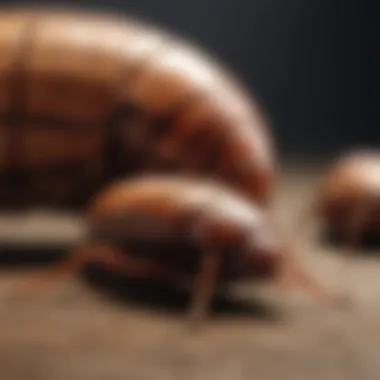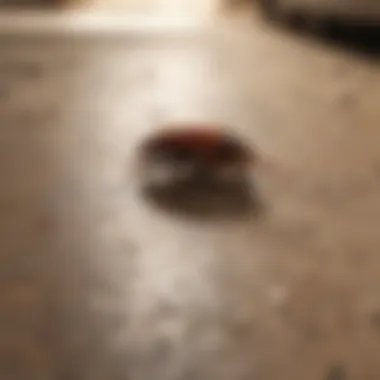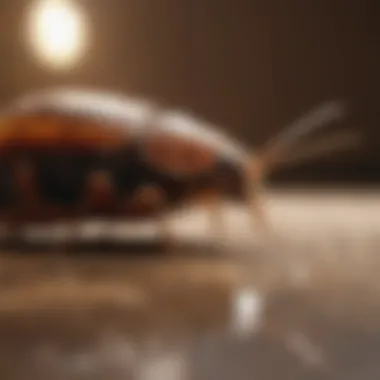Understanding and Managing Roaches in Your New Home


Intro
Roaches are one of the most common pests that homeowners encounter. Their presence can be unsettling, especially in a new home. Knowing how to identify, understand, and manage these creatures is essential for maintaining a healthy living environment. This article delves into the various aspects of roaches, including their characteristics, behavior, and effective management strategies. The goal is to empower homeowners with the necessary knowledge to act decisively against roach infestations.
Animal Overview
Common Name and Scientific Classification
Roaches, belonging to the order Blattodea, include over 4,000 species. The most noted species found in homes are the American Cockroach (Periplaneta americana), the German Cockroach (Blattella germanica), and the Oriental Cockroach (Blatta orientalis). Each species has unique traits that influence its behavior and habitat preferences.
Physical Characteristics
Roaches typically have a flat, oval body that aids in hiding in narrow spaces. An adult American Cockroach can grow up to 3.5 inches in length while the German Cockroach is smaller, around 1.5 inches. Their color ranges from dark brown to reddish-brown, and they have long antennae that help them navigate their environments.
Habitat and Distribution
Roaches thrive in diverse environments. They prefer warm, dark spaces, such as kitchens and bathrooms, where food and moisture are readily available. Common habitats include cracks, crevices, and under sinks. Distribution varies by species; for instance, the American Cockroach is more common in southern regions, while the German Cockroach is found widely in urban areas.
Key point: Understanding the specific species of roach in your home is crucial for effective management.
Behavior and Social Structure
Communication Methods
Roaches exhibit various communication methods, including the use of pheromones. These chemical signals convey information about food sources and warn of danger. Roaches often congregate due to their social nature, which strengthens their survival instincts.
Social Hierarchies
While not as structured as other societies, roaches do display some degree of hierarchy, often influenced by factors like food availability. Stronger individuals may dominate access to resources, leading to competition among lesser individuals.
Mating and Reproductive Behavior
Mating occurs throughout the year, with the female laying dozens of eggs in oothecae, which are protective cases. The number of eggs varies by species, but a single female can produce several hundred offspring over her lifetime, leading to rapid population increases if not managed.
Conservation Status
Current Population Trends
Roaches are generally resilient and thrive in urban environments. Their population continues to increase in areas where conditions are favorable. Factors like climate change may also impact their distribution and behavior.
Threats and Challenges
Despite being adaptable, roaches face threats from pesticides and habitat destruction. Increased awareness of health risks associated with roaches has led to significant actions against their populations in urban settings.
Conservation Efforts and Success Stories
While conservation efforts focus more on endangered species, controlling roaches is crucial for improving human health and living conditions. Integrated Pest Management (IPM) methods highlight successful strategies used by various organizations to minimize roach populations effectively.
Ending
Understanding roaches is the first step in managing them effectively. Homeowners must recognize the species present, their behaviors, and the best prevention and management strategies available. This proactive approach will not only safeguard their homes but also enhance overall well-being.
Preface to Roaches in New Homes
Understanding the presence of roaches in newly acquired houses is critical for homeowners. Many people consider the aesthetic benefits of a new home, but often overlook pest management aspects. Roaches can pose serious health risks, contaminating food and surfaces, and can affect emotional well-being due to anxiety over infestations. By recognizing their potential presence and addressing them quickly, homeowners can ensure a healthier living environment.
Understanding Roach Infestations
Roach infestations can happen quietly, often going unnoticed until they become a significant issue. These pests are notorious for reproducing rapidly, leading to large populations in a short time. Factors contributing to infestations include easy access to food, water, and warmth, which are all factors prevalent in many homes.


To understand roach infestations better, it is important to recognize how they operate. Adult roaches can survive for weeks without food, making them resilient against typical household practices. They often nest in hidden places, such as behind appliances or inside walls, making identification difficult. The presence of young roaches or egg cases are often the first visible signs of an infestation.
Why Roaches Are Common in New Houses
Roaches are often found in new houses for various reasons. First, during the construction phase, materials may come into contact with roach habitats. Building sites often disturb the soil, which can lead to relocating these pests. Thus, when the house is completed, roaches may already be in the structure, seeking refuge.
Second, new homes might create environments conducive to roach populations. Newly established homes may have inadequate sealing around walls or pipes, allowing easy entry. Construction materials can also unintentionally harbor moisture, creating perfect breeding grounds for roaches. Additionally, common household items such as unpacked boxes or stored food can further attract these pests.
Ensuring initial pest management is in place can be vital for new homeowners. Understanding the nuances of roach behavior and early infestation signs can help mitigate any long-term issues.
Common Types of Roaches Found in Homes
Understanding the common types of roaches found in homes is critical to effectively managing potential infestations. Each species has unique behaviors, habitats, and challenges that influence how homeowners should deal with them. By identifying the specific type of roach present, individuals can tailor their response and mitigation strategies accordingly. This knowledge not only enhances pest management efforts but also informs preventive tactics that can minimize future encounters.
American Cockroach
The American cockroach, recognized for its large size—reaching up to three inches in length—is often an unwelcome sight in homes. Its reddish-brown coloration with a yellowish margin on the thorax makes it easily identifiable. This species prefers damp, warm areas, commonly found in basements and near plumbing.
American cockroaches are particularly adaptive, capable of surviving for extended periods without food. Their presence can indicate moisture issues in the home, as they thrive in environments with high humidity.
– Behavioral Traits: They are nocturnal and shy away from light, making them elusive. This characteristic can complicate detection, emphasizing the importance of regular inspections.
– Health Concerns: Like many roaches, they can be carriers of allergens and pathogens, thus posing health risks to the inhabitants. Regular monitoring and immediate action can help mitigate these risks effectively.
German Cockroach
The German cockroach is smaller, typically measuring about half an inch long, yet it is one of the most common indoor pests. Recognizable by its light brown to tan color with two distinctive dark stripes running down its back, this species is notorious for its rapid reproduction rate.
It primarily inhabits kitchens and bathrooms, favoring warm and humid spots. The German cockroach often hides in cracks and crevices, which can make it difficult to spot until an infestation becomes serious.
– Reproduction: A female German cockroach can produce multiple egg cases, each containing up to 40 eggs, leading to rapid population growth if not addressed.
– Control Measures: Due to their prolific nature, homeowners need to implement both immediate and long-term control measures, like proper sanitation and targeted pesticide use, to effectively manage German cockroach infestations.
Oriental Cockroach
The Oriental cockroach, often referred to as the “water bug,” is larger than the German variety, measuring about one to one and a half inches long. Its dark, almost black coloration makes it less visually alarming than other species. However, it thrives in the same damp areas that attract the American cockroach, often more common in basements and drains.
– Habitat Preferences: Unlike other roaches, the Oriental cockroach prefers cooler environments, which influences their habits and behavior. They are less likely to wander into living spaces compared to their counterparts, but this does not diminish their potential for infestation.
– Resource Management: Effective management requires addressing moisture issues and sealing entry points. Being diligent in controlling food and water sources close to their habitat can help deter these pests.
Understanding the different types of roaches is paramount for effective management. Each species requires a specific approach tailored to their distinct behaviors and habitats.
Signs of a Roach Infestation
Recognizing the signs of a roach infestation is essential for effective intervention. Early detection not only helps in mitigating the problem but also prevents further spread. Knowing how to identify these signs equips homeowners and tenants to take immediate action.
Identifying Physical Evidence
Physical evidence of roaches includes droppings, egg cases, and shed skins. These indicators are often found in areas where roaches frequent.
- Droppings: Small black or brown specks are the most common droppings. They can vary in size, usually resembling a grain of black pepper. Finding these in kitchen cupboards or under sinks is a strong indication of an infestation.
- Egg Cases: Cockroaches produce egg cases called oothecae, which are reddish-brown and oval-shaped. Each case can contain multiple eggs. Seeing these in dark corners or behind appliances signals a serious problem.
- Shed Skins: As roaches grow, they shed their exoskeletons. Finding these cast-off skins in hidden areas is another sign of their presence.
Paying attention to these signs can uncover the extent of the infestation. Addressing the situation early is crucial.
Behavioral Indicators to Watch For
Certain behaviors exhibit the presence of roaches, making them clear indicators of an infestation beyond physical evidence.
- Nocturnal Activity: Roaches are primarily nocturnal. If you observe them scurrying across countertops or floors at night, this is a strong indication that they are residing in your home.
- Strange Odors: An unusual musty smell in your home can also suggest a roach problem. The smell comes from the pheromones they emit.
- Food Damage: Unexplained damage to packaged food items is a sign they have made a home in your pantry. Look for holes or chew marks on boxes and packaging.


It is vital to monitor these behaviors closely to gauge whether a more entrenched infestation exists. By being vigilant in identifying these indicators, you can act swiftly and appropriately.
Factors Contributing to Roach Infestations
Understanding the factors that contribute to roach infestations is crucial for effectively managing these pests in a new home. Several elements can attract roaches and create an inviting environment for them to thrive. Identifying these factors helps homeowners take proactive measures to minimize the likelihood of an infestation.
Humidity and Temperature Levels
Roaches are highly resilient creatures, but they have specific environmental preferences. High humidity and warm temperatures create ideal conditions for their survival. Generally, roaches thrive in environments where humidity exceeds 50%. The warm, damp spots in kitchens and bathrooms often provide the moisture they require.
Additionally, roaches prefer a temperature range between 75°F and 95°F (approximately 24°C to 35°C). Homeowners should monitor indoor climate conditions, particularly during hot months, when windows and doors are less frequently opened. Excessive humidity can often point to broader issues like leaks or condensation, thereby necessitating immediate attention.
Availability of Food and Water Sources
Food and water availability stands as one of the most important factors for roach infestations. These pests are opportunistic feeders. They can consume a wide range of food products, from crumbs on counters to waste lying around. Even items that might seem undesirable to humans, such as pet food or discarded food wrappers, can attract roaches.
In kitchens, ensure that leftovers are properly stored and that sinks are clean and dry. Regularly check pantry items for any spills or expired goods that may attract these pests. Fixing plumbing leaks is essential to eliminate excess water, as roaches only need a small amount of liquid to survive.
Structural Vulnerabilities of the House
A new house may also have structural vulnerabilities that serve as entry points for roaches. Cracks in foundations, gaps around windows and doors, and openings within walls can allow these pests to invade. It is important to conduct a thorough inspection of the property to identify and seal any potential entry points.
Paying attention to hidden areas of the home, like attics and basements, is equally vital. Even small crevices around plumbing or wiring can provide access for roaches. By enhancing the structural integrity of the home, homeowners can effectively reduce the risk of a roach invasion.
Identifying and addressing these factors can significantly contribute to maintaining a roach-free environment.
Prevention Strategies for Roaches
Roach prevention is a critical aspect of home ownership, especially in new houses. Understanding how to effectively keep these pests at bay can significantly enhance the overall quality of life in your space. Implementing the right prevention strategies not only protects your home from infestation but also contributes to a healthier living environment. By focusing on cleanliness, sealing potential entry points, and regulating indoor climate, homeowners can adopt a proactive approach to this issue.
Maintaining Cleanliness in the Home
One of the simplest yet most effective methods to prevent roaches is to maintain a clean home. Regular cleaning helps eliminate food sources and potential hiding places for roaches. Here are some key tips to maximize cleanliness:
- Regularly sweep and mop floors. Roaches are attracted to crumbs and spills, so ensuring these areas are clean is crucial.
- Store food properly. Use airtight containers for all consumables and avoid leaving pet food out overnight.
- Dispose of garbage frequently. Use bins with tight-fitting lids to prevent access.
Paying attention to all areas, including kitchens, dining rooms, and even less frequented spaces like under furniture, is essential. Regular inspections can also help identify potential problem areas before they escalate into more significant issues.
Sealing Entry Points
Sealing entry points is vital in preventing roaches from finding their way inside. Roaches can enter through small crevices, so addressing vulnerabilities in the home’s structure should be a priority. Focus on the following areas:
- Check for gaps. Inspect windows, doors, and any other openings, including those for vents and pipes. Use caulk to fill small cracks.
- Replace weather stripping. Ensure it is in good condition to prevent gaps where roaches can enter.
- Install door sweeps. A simple door sweep can create a barrier that prevents roaches from sneaking in under doors.
These proactive measures create a defensive barrier against not only roaches but other potential pests as well.
Regulating Indoor Climate
Roaches thrive in humid environments. To reduce their chances of survival, homeowners should focus on regulating the indoor climate. Achieving a suitable indoor environment involves:
- Using dehumidifiers. A dehumidifier can effectively reduce moisture levels in the air, making it less hospitable for roaches.
- Ventilation. Ensure adequate ventilation in bathrooms and kitchens to prevent moisture buildup.
- Fix leaks promptly. Check for leaky pipes or faucets and make necessary repairs to eliminate water sources.
By managing the humidity levels and keeping the air circulation steady, homeowners can create less attractive living conditions for roaches, thus minimizing the risk of an infestation.
Taking preventive measures is essential for maintaining a roach-free home. By understanding the habits of roaches and addressing these areas, you set a foundation for a healthier living space.
Effective Methods for Managing Roach Infestations
Managing a roach infestation is crucial for maintaining a healthy living environment. Effective methods not only address the immediate problem but also contribute to long-term solutions. Knowing how to handle this situation can lead to a significant improvement in comfort and sanitation in your home.


Chemical Solutions: Pesticides and Their Proper Use
Chemical solutions such as pesticides are often the first line of defense against roach infestations. These products can be effective in reducing roach populations swiftly. However, it's essential to utilize them properly to avoid potential health risks to humans and pets.
When selecting a pesticide, look for products specifically formulated for roaches. Read the label carefully to understand the active ingredients. While using these chemicals, it is vital to follow the manufacturer's instructions regarding application and safety measures. As you apply, ensure adequate ventilation in the area and keep living spaces clear of children and pets.
Additionally, consider targeting key areas like cracks, crevices, and behind appliances where roaches hide. It helps in maximizing the effectiveness of the pesticides. Make sure to repeat treatments as necessary until the infestation is under control.
Natural Remedies: Non-Toxic Alternatives
For those who prefer a less aggressive approach, natural remedies offer various non-toxic alternatives. Substances like diatomaceous earth, boric acid, and essential oils can deter and even eliminate roaches without harsh chemicals.
Diatomaceous earth works by damaging the exoskeleton of the roaches upon contact. To use it effectively, sprinkle it in areas where roaches frequent.
Boric acid, on the other hand, is a slow-acting substance that roaches ingest as they groom themselves. When utilizing boric acid, apply it in small amounts in hidden areas for safety.
Essential oils such as peppermint and tea tree oil can also act as natural repellents. Mix these oils with water and spray the solution around your home. While these methods may not provide immediate results like chemical solutions, they contribute to a safer home environment over time.
Professional Extermination Services
In some cases, DIY methods may not suffice, and professional extermination services become necessary. These experts bring advanced techniques and tools to effectively manage severe infestations. Professionals are trained to assess the situation accurately and determine the best course of action.
When considering hiring a company, research their reputation by looking for online reviews. Ask about their methods, whether they use chemical or non-toxic options, and inquire about follow-up services. A comprehensive approach often includes an initial treatment followed by monitoring and preventive strategies. Working with professionals can not only resolve your immediate issue but can also provide insights into maintaining a roach-free environment long-term.
Long-Term Roach Management Plans
Managing a roach problem is not solely about immediate action; it involves establishing a framework for long-term prevention and control. Long-term roach management plans are crucial for ensuring that infestations do not recur. Such plans help maintain a clean environment, which in turn, discourages roaches from returning. Homeowners must focus on several key elements while crafting these plans.
Importance of Long-Term Roach Management Plans
A long-term roach management plan comprises routine activities that prevent infestations before they start. This proactive approach reduces the stress and costs associated with dealing with reoccurring problems. It’s essential to recognize that even with successful removal, factors such as environmental conditions and structural vulnerabilities may still favor roach survival.
- Continuous Monitoring: Regular inspections are important to catch any signs of roaches early.
- Environmental Control: Assessing and managing humidity, temperature, and cleanliness reduces ideal conditions for roaches.
- Education: Staying informed about the habits of roaches and new management strategies empowers homeowners against potential infestations.
Regular Monitoring Techniques
To maintain vigilance, homeowners should implement systematic monitoring techniques. Regular checks can identify minor roach problems before they escalate.
- Weekly Inspections: Check common hiding spots such as under sinks, behind appliances, and in cabinets.
- Setting Traps: Utilize sticky traps to capture any roaches present. This aids in assessing the severity of infestations.
- Recording Trends: Keeping track of sightings and trap catches helps determine patterns and potential problem areas.
Regular monitoring is an integral component of a successful long-term roach management plan.
Integrating Preventive Habits
Creating a preventive mindset is essential for long-lasting effects. This involves integrating simple yet effective habits into your daily routine.
- Cleanliness: Maintaining a clutter-free environment where crumbs and spills are promptly cleaned can deter roaches.
- Proper Food Storage: Use airtight containers for food storage to minimize accessibility.
- Seal Openings: Regularly inspect and seal any cracks, gaps, or holes that could serve as entry points for roaches.
Implementing these preventive habits not only reduces roach populations but also encourages a healthier living environment overall.
Culmination
The issue of roach management in a new home is not trivial. Understanding the importance of effective strategies can drastically reduce stress linked to infestations and contribute to overall household hygiene. Roaches can pose health risks and can damage property, making it essential to address any concerns promptly.
Summarizing Effective Strategies
To effectively manage roaches, several strategies should be adopted. These include:
- Regular Cleaning: Keep surfaces clear of crumbs and spills to eliminate food sources for roaches.
- Sealing Entry Points: Thoroughly inspect and seal cracks and crevices in walls, around doors, and windows to limit entry.
- Humidity Control: Use dehumidifiers in areas prone to dampness, making the environment less hospitable for roaches.
- Pesticide Use: Identify the correct pesticide and follow instructions to ensure safety and effectiveness. If preferable, opt for non-toxic alternatives.
Regularly implementing these strategies can greatly reduce the likelihood of an infestation.
Encouragement for Ongoing Vigilance
Vigilance is key in maintaining a roach-free home. Homeowners should regularly monitor for signs of roaches even after implementing preventive measures. Continuous commitment to cleanliness, regular inspections, and being proactive about sealing entry points can make a significant difference. Consider establishing an inspection schedule that fits within your routine. Recognize that complacency can re-open the door to potential infestations.
By staying alert and informed, homeowners can foster a healthier living environment and ensure their space remains free from these unwelcome guests.







